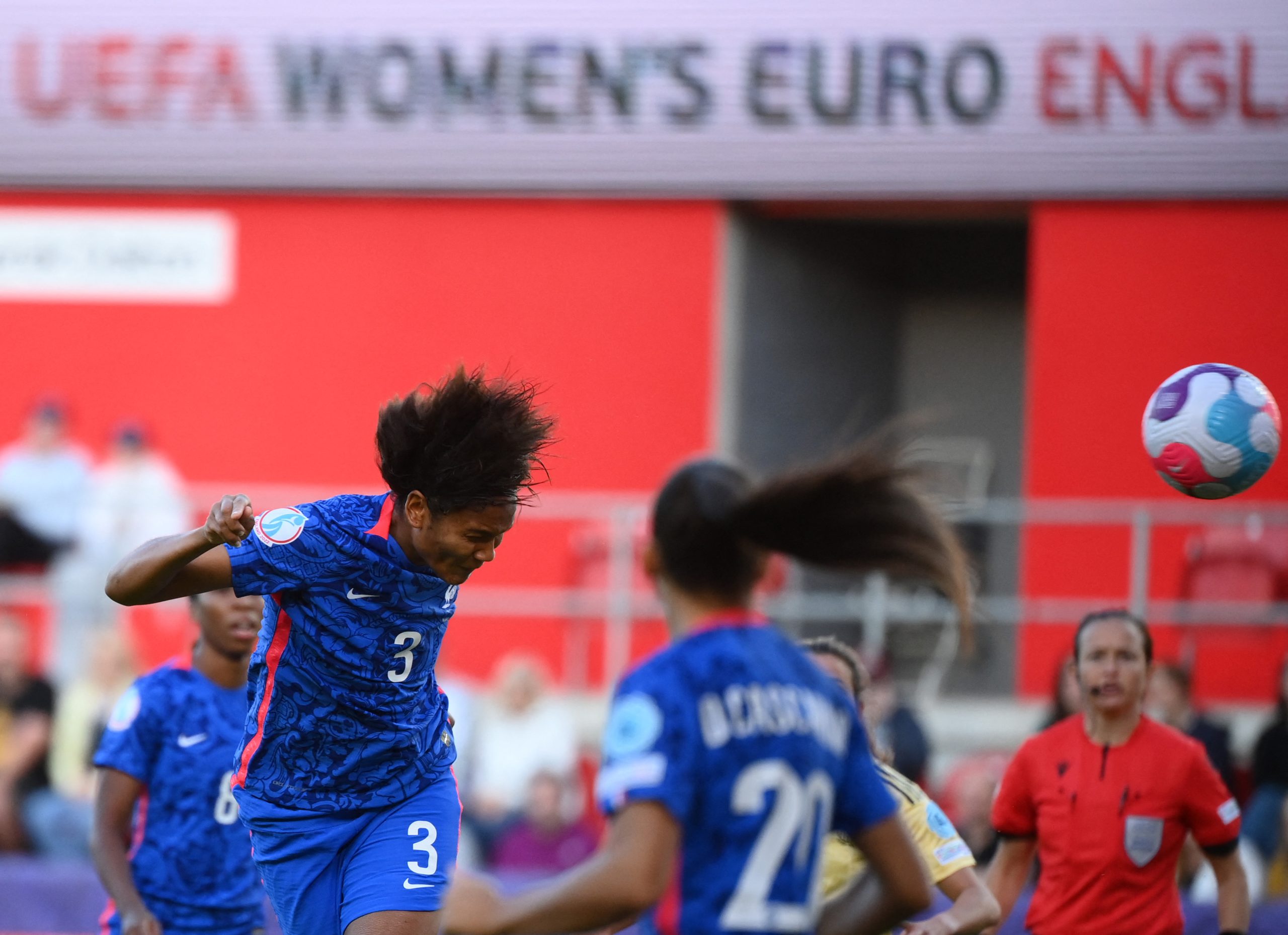Johan Cryuff has given us, among other things, some of the most recognizable quotes in football. One of them reads, “you play football with your head, and your legs are there to help you.” Now, this was aimed to be a quote about the importance of using your head to solve in-game situations on the fly, but let’s put our spin on it.
Using your head, in the very literal sense, is a valuable quality on the football pitch. Although heading the ball has been under scrutiny due to the micro-trauma it can cause and the long-term risks of concussion, even prompting discussions around whether removing heading the ball outside of the penalty boxes is an option, headers add a different dimension to a team’s offensive ideas.
It’s a difficult skill to master and control but has been a mainstay of a team’s attacking principles. There has been a clear upward trend in the volume of headed shots at the ongoing Women’s Euros, with the number rising to 5.2 headed shots per game in the current edition in comparison to 4.3 per game in 2013. While teams have marginally improved on their headed shot volume, they have become significantly better at converting these shots into goals.
The 2022 edition of the Euros has been a goalfest, with 85 goals scored at a rate of 3.04 goals per game. We have already witnessed 24 headed goals in this tournament, almost as many as the previous two editions combined (27) with three games remaining. This isn’t just a change in the raw volume of goals, the headed shots per goal figure has significantly gone down from 8.3 in 2013 and 8.6 in 2017 to just 6.0 in the current edition.
Four teams from the current edition rank in the top six for headed goals scored at the Euros in the Opta database which dates back to the 2013 edition and the current edition is still ongoing.
Germany have scored five goals from 17 headed shots in this year’s tournament while Spain have scored four from the same number of headed shots. Wolfsburg and Germany striker, Alexandra Popp, playing her first ever Euros after missing the earlier editions with unfortunate injuries, leads the chart for most goals from headers in the last three editions with three goals from seven headed shots.
So what is happening here? Are teams getting better at generating headed opportunities and is it a part of some larger tactical trend? Are players simply better at heading the ball? Is it a height phenomenon? Let’s try to dissect it.
Set-Piece Prowess
The game is constantly evolving. Teams are getting better tactically with increased emphasis on possession play. Consequently the players are developing to be better on the ball in recent years. The increased investment in the women’s game has helped make up some lost ground.
These advancements have helped level the playing field in some ways. Teams trying to gain a valuable edge on their opposition have come up with innovative solutions for goalscoring problems. One of the most prominent solutions has been the set-piece development.
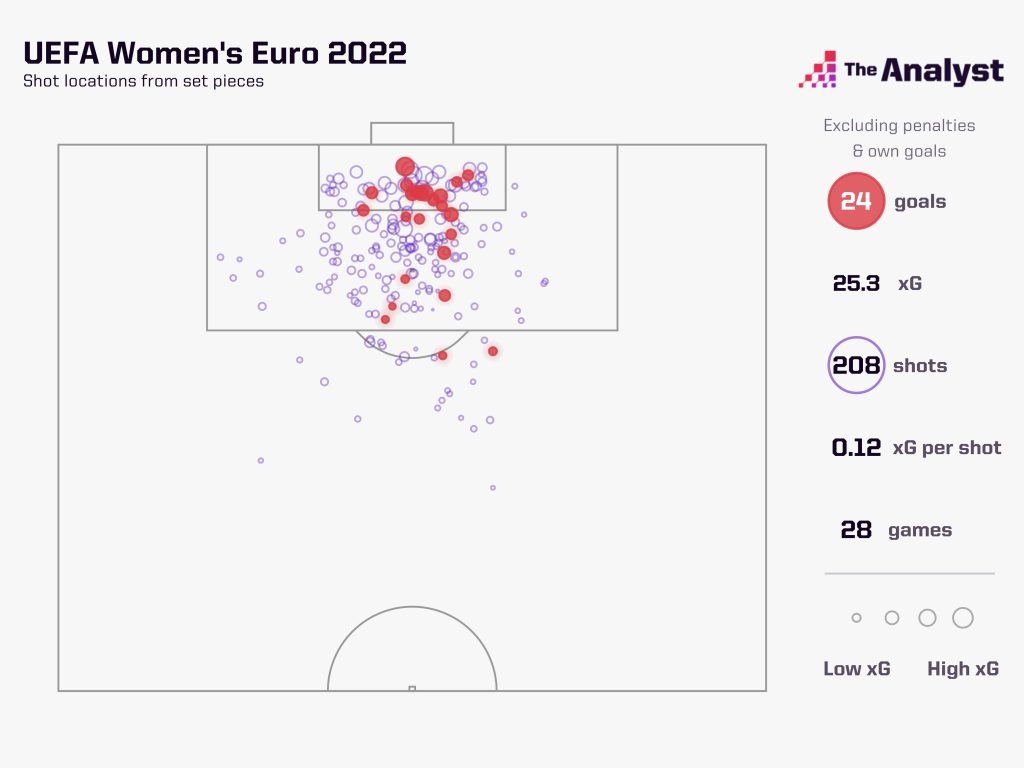
Teams have started to incorporate set-pieces as an important aspect of their game model and have come up with creative strategies to exploit the opposition’s shape. Excluding penalties, 26 out of 77 goals scored so far have come from set-pieces (34%). Of non-penalty shots, 55% of headed attempts at this year’s Euros have come from either corner or set-pieces. So set-pieces clearly matter, especially in international knockout style tournaments.
At the current Euros, Iceland have been an example of this strategy. Ranked 16th in the world, Iceland accumulated the highest xG total from non-penalty set-piece situations in the tournament (3.61) and a whopping 72% of their total xG came from these set plays. They are at the top in the competition for most headed shots per game at 4.7, and a large portion of that is down to their excellent set-pieces and a secret weapon in their attacking repertoire – long throw-ins.
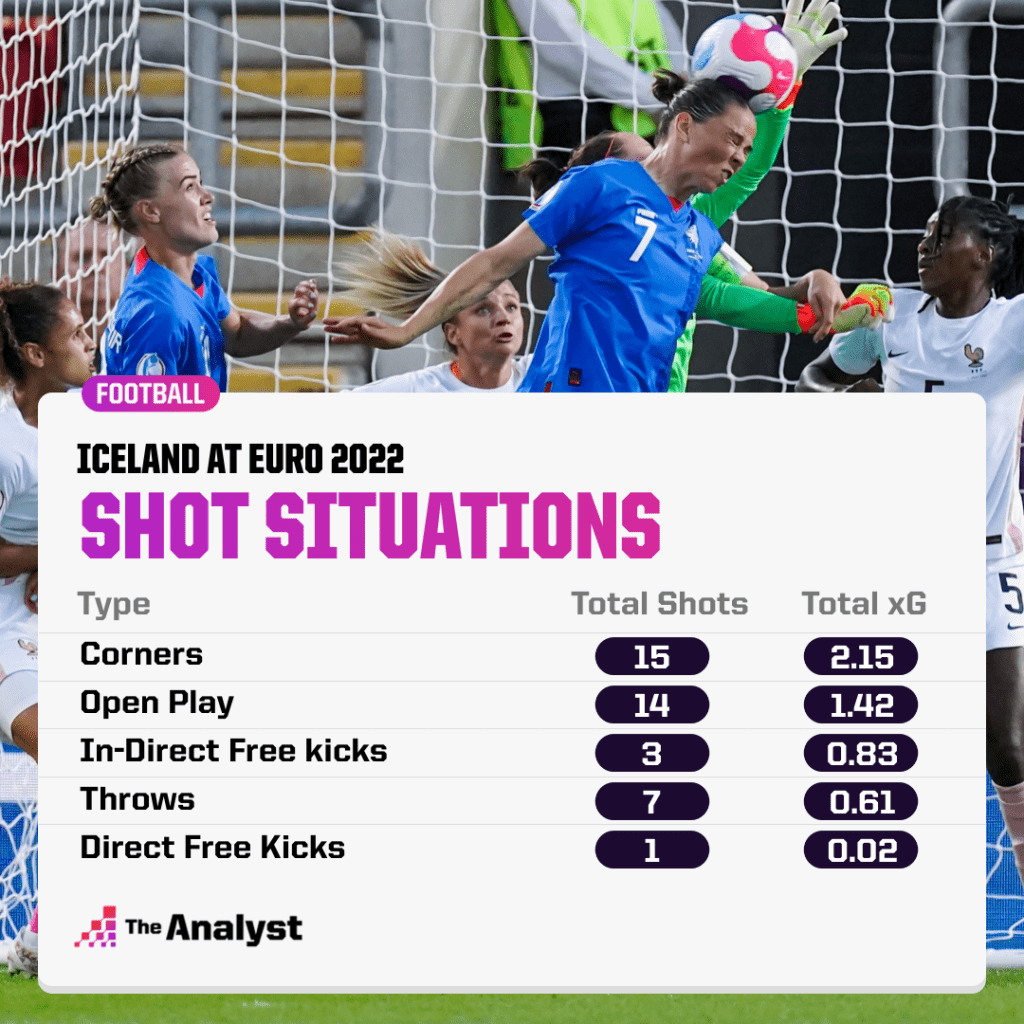
Dagny Brynjarsdottir, known for her ability to pounce on these aerial balls in the box, is one of the main beneficiaries of this. Out of her 23 shots in the WSL last season, 11 of them were headers and she has recorded the most headed shots for Iceland at the Euros as well. Her height, standing at 5-foot-11, and uncanny awareness to attack the aerial balls makes her a consistent threat in the box. She averaged just over four aerial duels won per game at the Euros.
In our preview for the Euros, we noted Sveindis Jonsdottir’s Rory Delap-esque long throw-ins as an important strategy for Iceland and the Nordic nation scored a goal from one of those long deliveries.
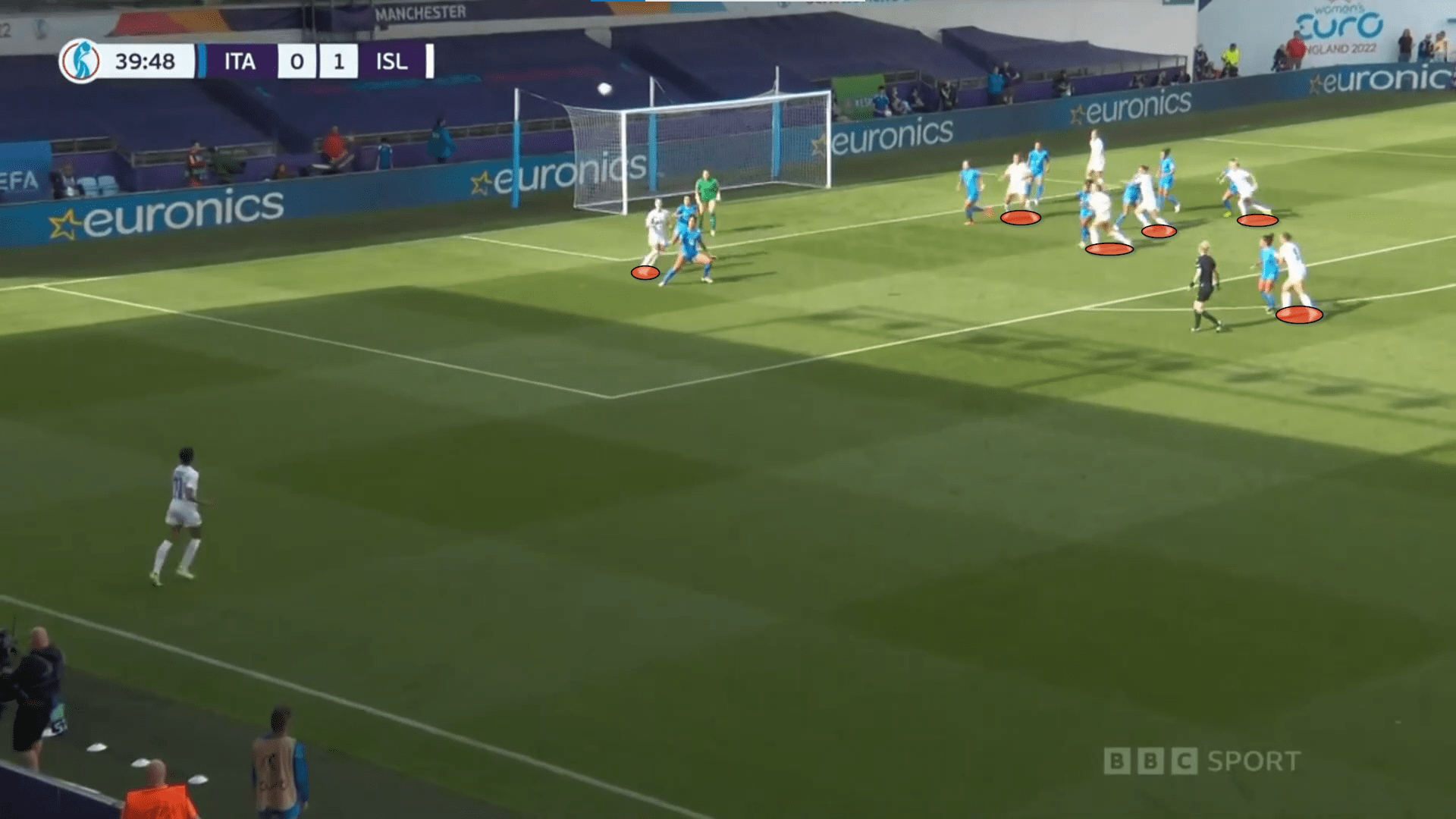
Iceland’s setup on these long throw-ins is built around attacking the second ball either after an initial header or awkward bounce in the box. Look at the five players Iceland (in white) have ready at the far post to attack the second balls and in case nobody manages to get to it and the ball is bouncing in the box, they have a player situated right at the edge of the box to attack that, which is how the goal came about. These long throw-ins are agents of chaos in the box and it’s a rare trait in football, hence teams are often clueless when faced with them.
Another team that has benefitted from maximizing their set-pieces is Portugal. Following their late inclusion into this year’s Women’s Euros, Francisco Neto’s side didn’t have much time to prepare coming in and focused their attention on designing an effective set-piece routine to compensate for what they lacked in other departments. Across the group stage, they accumulated the second highest xG from set-pieces at Euro 2022.
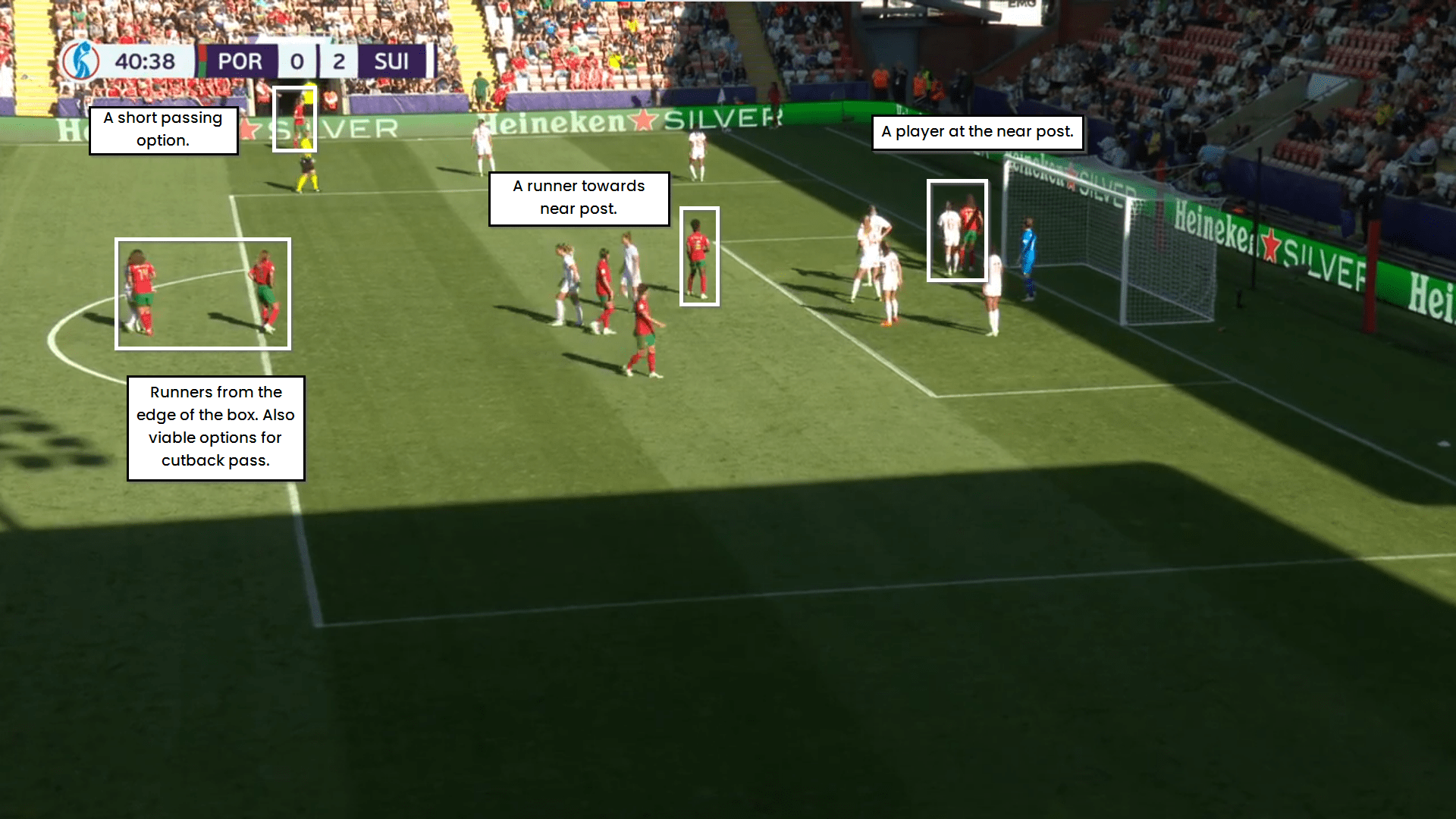
In particular, their corner routine has been very effective and helped them pull off a comeback draw against Switzerland in the first game. Their setup allowed them to exploit near post and far post and a combination of good movements resulted in space in the middle for aerially dominant players like centre-back Diana Gomes. They switched things up from time to time by playing a cutback to the options at the edge of the box as well. The variety on offer in these situations was the spice of their attack.
Set-pieces matter, and when devised strategically can help you gain edge over your opponent.
Height, Jump Reach and Timing
Obviously when it comes to aspects like heading the ball, one can’t look past the role of height in winning these aerial battles. While jump timing and reach are important factors, height does play a decisive role in winning headers.
This is just one of the reasons why players like Wendie Renard, Dagny Brynjarsdottir and Irene Paredes are so good in the air. Renard is a towering presence at 6-foot-2 while Paredes stands at 5-foot-8, defending against them in the box is easier said than done. Assigning multiple players on them opens up space for other players, so it’s a double edged sword.
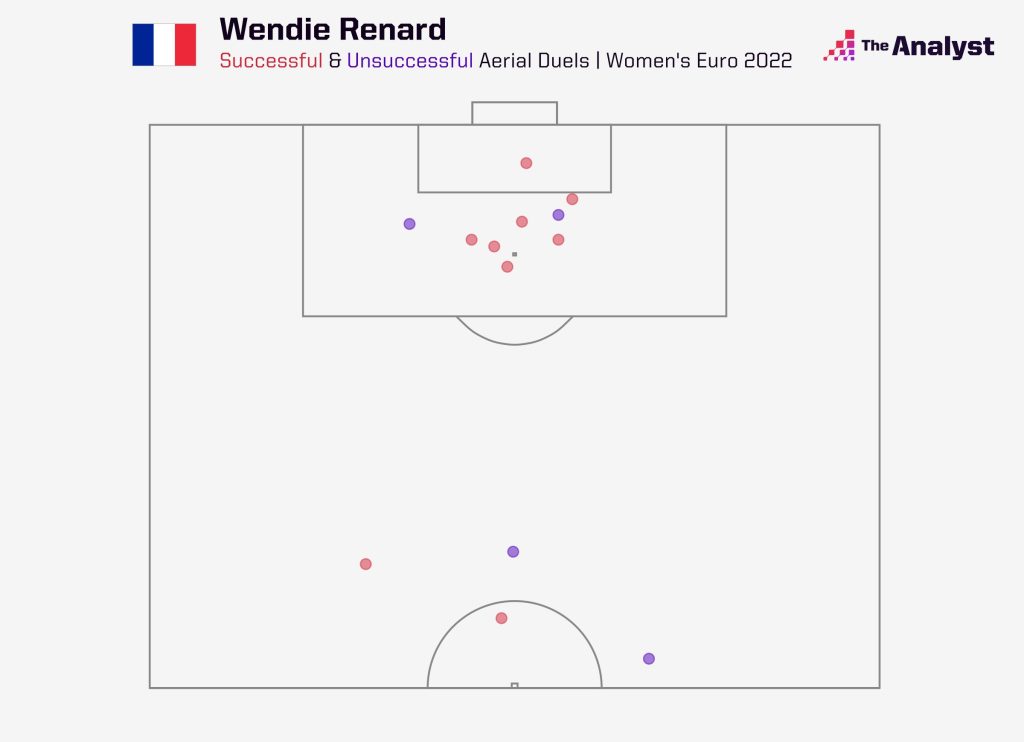
France veteran centre-back and captain, Renard is another example of this. She is renowned for her aerial ability. She is so good at it that she is the highest shot-taker at the Euros this year (17) with 76% of those shots being headers. Being so tall, she is easily the most recognizable target in the box from set-play and coupled with her ability to peel away from defenders into space make her very hard to defend against. France particularly try to facilitate this with some set-piece routine, where they remain tight to Renard as the ball is played in thus making it difficult for the opposition to mark her closely while keeping an eye on the ball.
Spain and Barcelona centre-back, Paredes, is another example of this. She recorded six headed shots in the tournament, fewer than only Popp (7) and Renard (13). Her height and reading of the game gives her an advantage in aerial duels, with the Spanish center-back having a 67% success rate on aerial battles.
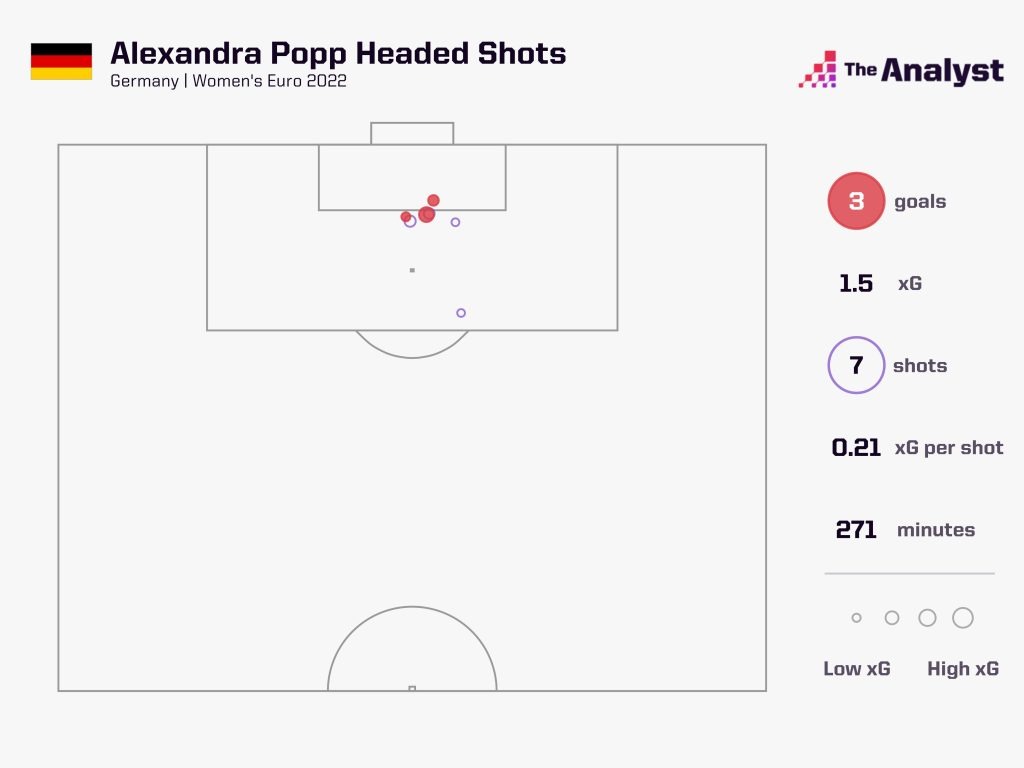
Another key physical factor in winning aerial duels is jump reach. Germany’s Alexandra Popp is a great example of this. At 5-foot-7, Popp isn’t a towering presence like Renard but she times her jump to perfection and her reach is excellent. She too has a 67% success rate on her aerial duels and three out of four of Popp’s goals so far have been from headers as well. Her jump reach and timing fused with her physicality make her an excellent outlet for route one football, allowing her to turn playmaker with flick-ons while helping her goal-scoring abilities.
It’s a similar case with England and Manchester United’s striker, Alessia Russo, who stands at 5-foot-7 but her overpowering physical nature, jump and the ability to attack the aerial balls help her edge ahead of her marker. She has scored two goals from headers in the tournament and an example of how her aerial ability is helpful for her side was demonstrated by her role in the equaliser England scored against Spain in the quarter-finals.
An Anomaly or Not?
Spain has been among the teams with most headed shots at the tournament in the last two editions of the Women’s Euros. On the surface that might seem a little odd for a team renowned for their intricate and incisive passing on the ground to then score goals and get shots off in the form of headers. Four out of Spain’s six goals in the tournament have been headers. They are only marginally behind France (4.5) in terms of headed shots per game with 4.3 and they aren’t particularly a tall side either.
So what is going on here? What seems like an anomaly on the surface, starts to make sense as you ruminate on it.
Spain likes to keep the ball, their average possession in the last two editions has been 75.4% and 69.1% respectively, and teams are largely happy letting them do so. This presents itself as an interesting tactical puzzle on the pitch for Spain to solve.
As their playing style has become more refined in terms of on-ball principles, teams have increasingly set-up to deny them space in front of goal. They want Spain to keep possession in front of their compact shape and funnel them towards the wide areas. Jorge Vilda’s side thus find themselves working with space in the wide areas and by extension have to resort to crossing.
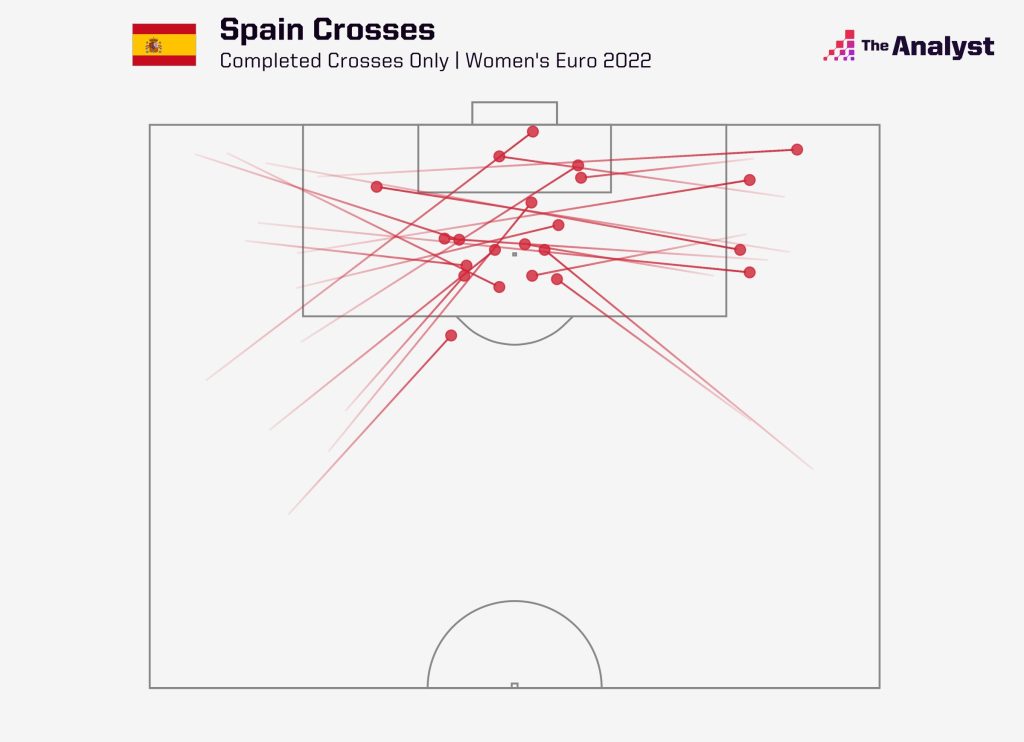
Their number of open-play crosses per game has gone up from 15.5 in 2013 to 19.3 in 2017 to 21.5 in 2022, a figure that sits only behind France with 32 crosses per game in 2013 since this metric was first recorded in the tournament. Spain, even if it’s not the best use of the tools at their disposal, find themselves returning to crossing more often than not.
Crossing, in general, isn’t always the most efficient way of attacking, with a shot every six crosses but a healthy 71% of those shots are headers, which makes sense given the aerial nature of most of these deliveries from out wide.
Spain have averaged a shot every 5.9 crosses at the Euros this year and 81% of these shots are headers. Not really an efficient way even more so when you factor in that Spain at this tournament have mostly played without a recognised striker upfront to attack these deliveries on top of most of their striker options lacking the aerial prowess in the first place.
With their on-ball and territorial dominance, Spain often find themselves attempting a very high volume of these crosses, thus presenting themselves with more opportunities to head the ball. So an anomaly? Well not quite.
Enjoy this? Subscribe to our mailing list to receive exclusive weekly content.
